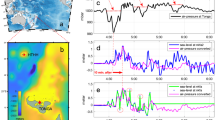Abstract
On the evening of 15 January 2022, the Hunga Tonga-Hunga Ha’apai volcano1 unleashed a violent underwater eruption, blanketing the surrounding land masses in ash and debris2,3. The eruption generated tsunamis observed around the world. An event of this type last occurred in 1883 during the eruption of Krakatau4, and thus we have the first observations of a tsunami from a large emergent volcanic eruption captured with modern instrumentation. Here we show that the explosive eruption generated waves through multiple mechanisms, including: (1) air–sea coupling with the initial and powerful shock wave radiating out from the explosion in the immediate vicinity of the eruption; (2) collapse of the water cavity created by the underwater explosion; and (3) air–sea coupling with the air-pressure pulse that circled the Earth several times, leading to a global tsunami. In the near field, tsunami impacts are strongly controlled by the water-cavity source whereas the far-field tsunami, which was unusually persistent, can be largely described by the air-pressure pulse mechanism. Catastrophic damage in some harbours in the far field was averted by just tens of centimetres, implying that a modest sea level rise combined with a future, similar event would lead to a step-function increase in impacts on infrastructure. Piecing together the complexity of this event has broad implications for coastal hazards in similar geophysical settings, suggesting a currently neglected source of global tsunamis.
This is a preview of subscription content, access via your institution
Access options
Access Nature and 54 other Nature Portfolio journals
Get Nature+, our best-value online-access subscription
$32.99 / 30 days
cancel any time
Subscribe to this journal
Receive 51 print issues and online access
$199.00 per year
only $3.90 per issue
Buy this article
- Purchase on SpringerLink
- Instant access to full article PDF
Prices may be subject to local taxes which are calculated during checkout




Similar content being viewed by others
Data availability
All of the processed data, scripts used to create the Extended Data figures and examples of raw data processing used in this manuscript can be freely accessed at https://www.designsafe-ci.org/, referencing Data Depot project no. PRJ-3474 (https://doi.org/10.17603/ds2-6hx4-ke44). Pressure data were provided by NOAA (https://noaa.gov), the Japan Meteorological Agency (https://www.jma.go.jp/jma/indexe.html), the Fiji Meteorological Service (https://www.met.gov.fj/) and the Tonga Meteorological Service (http://met.gov.to/). DART sensor data were provided by the New Zealand GeoNet project (https://www.geonet.org.nz/tsunami/dart) and the US National Data Buoy Center (https://www.ndbc.noaa.gov/obs.shtml?lat=13&lon=-173&zoom=2&pgm=tsunami). Tide station records were provided by the Sea Level Station Monitoring Facility (https://www.ioc-sealevelmonitoring.org/).
Code availability
The model source code, simulation control and input files and output processing scripts for the COULWAVE simulations presented in this paper can be freely accessed at https://www.designsafe-ci.org/, referencing Data Depot project no. PRJ-3474 (https://doi.org/10.17603/ds2-6hx4-ke44).
References
Cronin, S. J. et al. New volcanic island unveils explosive past. Eos https://doi.org/10.1029/2017EO076589 (2017).
Witze, A. Why the Tongan eruption will go down in the history of volcanology. Nature 602, 376–378 (2022).
M 5.8 Volcanic Eruption – 68 km NNW of Nuku'alofa, Tonga. 15 January 2022 (USGS, retrieved 15 January 2022); https://earthquake.usgs.gov/earthquakes/eventpage/us7000gc8r/executive
Self, S. & Rampino, M. R. The 1883 eruption of Krakatau. Nature 294, 699–704 (1981).
Schofield, J. C. Notes on the geology of the Tongan Islands. N. Z. J. Geol. Geophys. 10, 1424–1428 (1967).
Garvin, J. B. et al. Monitoring and modeling the rapid evolution of earth's newest volcanic island: Hunga Tonga Hunga Ha'apai (Tonga) using high spatial resolution satellite observations. Geophys. Res. Lett. 45, 3445–3452 (2018).
Brenna, M. et al. Post-caldera volcanism reveals shallow priming of an intra-ocean arc andesitic caldera: Hunga volcano, Tonga, SW Pacific. Lithos 412, 106614 (2022).
Poli, P. & Shapiro, N. M. Rapid characterization of large volcanic eruptions: measuring the impulse of the Hunga Tonga Ha’apai explosion from teleseismic waves. Geophys. Res. Lett. 49, e2022GL098123 (2022).
Carvajal, M., Sepúlveda, I., Gubler, A., & Garreaud, R. Worldwide signature of the 2022 Tonga volcanic tsunami. Geophys. Res. Lett. 49, 6 (2022).
Sigurdsson, H., Houghton, B., McNutt, S., Rymer, H. & Stix, J. The Encyclopedia of Volcanoes (Elsevier, 2015).
Nomanbhoy, N. & Satake, K. Generation mechanism of tsunamis from the 1883 Krakatau eruption. Geophys. Res. Lett. 22, 509–512 (1995).
Pararas-Carayannis, G. Near and far-field effects of tsunamis generated by the paroxysmal eruptions, explosions, caldera collapses and massive slope failures of the Krakatau volcano in Indonesia on August 26–27, 1883. Sci. Tsunami Hazards 4, 191–201 (2003).
Jordan, B. R. Tsunamis of the Arabian Peninsula a guide of historic events. Sci. Tsunami Hazards 27, 31 (2008).
Yeh, H., Liu, P., Briggs, M. & Synolakis, C. Propagation and amplification of tsunamis at coastal boundaries. Nature 372, 353–355 (1994).
Fry, B. et al. Sensor network warns of stealth tsunamis. Eos https://doi.org/10.1029/2020EO144274 (2020).
Borrero, J. C., Goring, D. G., Greer, S. D. & Power, W. L. Far-field tsunami hazard in New Zealand ports. Pure Appl. Geophys. 172, 731–756 (2015).
Borrero, J. & Greer, S. D. Comparison of the 2010 Chile and 2010 Japan tsunamis in the far-field. Pure Appl. Geophys. 170, 1249–1274 (2013).
Gilmour, A. E. Response of Wellington harbour to the tsunamis of 1960 and 1964. N. Z. J. Mar. Freshw. Res. 24, 229–231 (1990).
Kalligeris, N. et al. Lagrangian flow measurements and observations of the 2015 Chilean tsunami in Ventura, CA. Geophys. Res. Lett. 43, 5217–5224 (2016).
La Selle, M. et al. Observations of Tsunami and Runup Heights in Santa Cruz Harbor and Surrounding Beaches from the 2022 Hunga Tonga-Hunga Ha'apai Tsunami Technical Report (USGS, 2022); https://doi.org/10.5066/P9ZVAB8D
Inician acciones de respuesta luego de oleajes en el litoral (INDECI, 2022); https://www.gob.pe/institucion/indeci/noticias/576687-inician-acciones-de-respuesta-luego-de-oleajes-en-el-litoral
Peru: Oil Spill, flash update no. 02 (UNOCHA, 2022); https://reliefweb.int/report/peru/peru-oil-spill-flash-update-no-02-27-january-2022
Paris, R. Source mechanisms of volcanic tsunamis. Philos. Trans. A Math. Phys. Eng. Sci. 373, 20140380 (2015).
Medici, E. F., Allen, J. S. & Waite, G. P. Modeling shock waves generated by explosive volcanic eruptions. Geophys. Res. Lett. 41, 414–421 (2014).
Lamb, H. On the vibrations of an elastic sphere. Proc. Lond. Math. Soc. 1, 189–212 (1881).
Lamb, H. Hydrodynamics (Cambridge Univ. Press, 1932).
Yokoo, A., Ichihara, M., Goto, A. & Taniguchi, H. Atmospheric pressure waves in the field of volcanology. Shock Waves 15, 295–300 (2006).
Garrett, C. J. R. Atmospheric edge waves. Q. J. R. Meteorol. Soc. 95, 731–753 (1969).
Fitzgerald, T. J. Observations of total electron content perturbations on GPS signals caused by a ground level explosion. J. Atmos. Sol. Terr. Phys. 59, 829–834 (1997).
Stoker, J. J. Water Waves. The Mathematical Theory with Applications (Interscience Publ. Inc., 1957).
Amores, A. et al. Numerical simulation of atmospheric Lamb waves generated by the 2022 Hunga‐Tonga volcanic eruption. Geophys. Res. Lett. https://doi.org/10.1029/2022GL098240 (2022).
Latter, J. H. Tsunamis of volcanic origin: summary of causes, with particular reference to Krakatoa, 1883. Bull. Volcanol. 44, 467–490 (1981).
Shen, Y. et al. Laboratory experiments on tsunamigenic discrete subaqueous volcanic eruptions. Part 2: properties of generated waves. J. Geophys. Res. Oceans 126, e2020JC016587 (2021).
Kim, D. H., Lynett, P. J. & Socolofsky, S. A. A depth-integrated model for weakly dispersive, turbulent, and rotational fluid flows. Ocean Model. (Oxf.) 27, 198–214 (2009).
Harkrider, D., Press, K.The Krakatoa air-sea waves: an example of pulse propagation in coupled systems. Geophys. J. Int. 13, 149–159 (1967).
Monserrat, S., Vilibić, I. & Rabinovich, A. B. Meteotsunamis: atmospherically induced destructive ocean waves in the tsunami frequency band. Nat. Hazards Earth Syst. Sci. 6, 1035–1051 (2006).
Proudman, J. The effects on the sea of changes in atmospheric pressure. Geophys. J. Int. https://doi.org/10.1111/j.1365-246X.1929.tb05408.x (1929).
Vilibić, I. Numerical simulations of the Proudman resonance. Cont. Shelf Res. 28, 574–581 (2008).
Wilson, R. I. et al. Observations and impacts from the 2010 Chilean and 2011 Japanese tsunamis in California (USA). Pure Appl. Geophys. 170, 1127–1147 (2013).
Borrero, J. et al. Observations, effects and real time assessment of the March 11, 2011 Tohoku-oki tsunami in New Zealand. Pure Appl. Geophys. 170, 1229–1248 (2013).
UNOSAT Emergency Mapping service Activated over Tonga for the Volcanic Eruption and Induced Tsunami (UNITAR, accessed 20 January 2022); https://unitar.org/about/news-stories/news/unosat-emergency-mapping-service-activated-over-tonga-volcanic-eruption-and-induced-tsunami
Gridded Bathymetry Data: GEBCO_2020 Grid (General Bathymetric Chart of the Oceans, accessed 20 January 2022).
Peli, T. & Malah, D. A study of edge detection algorithms. Comput. Graph. Image Process. 20, 1–21 (1982).
Mori, N., Suzuki, T. & Kakuno, S. Noise of acoustic Doppler velocimeter data in bubbly flows. J. Eng. Mech. 133, 122–125 (2007).
Torrence, C. & Compo, P. A practical guide to wavelet analysis. Bull. Am. Meteorol. Soc. 79, 61–78 (1998).
Meteorological Stations, NOAA Tides and Currents (National Oceanic and Atmospheric Administration, accessed 20 January 2022).
Ocean Data Buoy Observations (Japan Meteorological Agency, accessed 20 January 2022).
Fiji Meteorological Service, Climate Services Division/Department of Meteorology, Ministry of Infrastructure, Transport, Disaster Management & Meteorological Services (accessed via data request).
Duncombe, J. The surprising reach of Tonga’s giant atmospheric waves. Eos https://doi.org/10.1029/2022EO220050 (2022).
Amazon Web Services Portal for GOES 17 Data https://noaa-goes17.s3.amazonaws.com (accessed 7 April 2022).
Wei, G., Kirby, J. T., Grilli, S. T. & Subramanya, R. A fully nonlinear Boussinesq model for surface waves. Part 1. Highly nonlinear unsteady waves. J. Fluid Mech. 294, 71–92 (1995).
Vilibić, I., Monserrat, S., Rabinovich, A. & Mihanović, H. Numerical modelling of the destructive meteotsunami of 15 June, 2006 on the coast of the Balearic Islands. Pure Appl. Geophys. 165, 2169–2195 (2008).
Regional: Pacific Disaster Resilience Program, Multi-Hazard Risk Assessment, Tongatapu Technical Risk Assessment, Report Prepared by Arup Australia for Asian Development Bank Project 50028-001 (ADB, 2021).
Borrero, J., Greer, D., McIntosh, R. & Damlamian, H. Tsunami hazard assessment for Tongatapu, Tonga. In Proc. Australasian Coasts & Ports 2021 Conference (2021).
Le Méhauté, B. & Wang, S. Water Waves Generated by Underwater Explosion Vol. 10 (World Scientific, 1966).
Dragoni, M. & Santoro, D. A model for the atmospheric shock wave produced by a strong volcanic explosion. Geophys. J. Int. 222, 735–742 (2020).
Lynett, P. J., Wu, T. R. & Liu, P. L. F. Modeling wave runup with depth-integrated equations. Coast. Eng. 46, 89–107 (2002).
Sitanggang, K. I. & Lynett, P. Parallel computation of a highly nonlinear Boussinesq equation model through domain decomposition. Int. J. Numer. Methods Fluids 49, 57–74 (2005).
Acknowledgements
The University of Southern California (USC) authors were supported by US NSF grant nos. CMMI-1661052, OCE-1830056 and ICER-1940315. Any opinions, findings and conclusions or recommendations expressed in this material are those of the authors and do not necessarily reflect the views of the National Science Foundation. This article has been peer reviewed and approved for publication consistent with USGS Fundamental Science Practices (https://pubs.usgs.gov/circ/1367/). Any use of trade, firm or product names is for descriptive purposes only and does not imply endorsement by the US Government. A. Kumar, from the Fiji Meteorological Service, Climate Services Division, assisted in providing the authors with atmospheric pressure data from Fiji. M. Paea, of the Ha'atafu Beach Resort, provided the photographs shown in Fig. 2c,d. The team acknowledges the USC Center for Advanced Research Computing for the 0.5 million central processing unit hours used for this modelling effort.
Author information
Authors and Affiliations
Contributions
P.L. was responsible for leading the overall team, developing the N-wave pressure pulse model and performing the numerical solutions. M.M. was responsible for performing the Ventura harbour field survey, organizing the manuscript and processing and curating the pressure time series data. Z.Z. was responsible for performing the Ventura harbour field survey, collecting observational data and creating visualizations with the model output. W.R. participated in the Ventura harbour field survey and collected and processed the DART and tide station data. J. Borrero., D.G., O.F. and C.B. collected reports and observations in the near field, processed New Zealand DART and tide station data and contributed to writing of the manuscript. B.J., S.L.S., A.R., A.S., B.N., J. Bolt. and N.G. completed the tsunami field survey of Santa Cruz harbour and surrounding areas, and processed the collected data. B.J., S.L.S. and A.R. contributed to writing of the manuscript. C.S. participated in delineation of source mechanisms and assisted in writing of the manuscript. B.E. and G.E.C. participated in the Ventura harbour field survey and assisted in writing of the manuscript. All authors discussed the results and commented on the manuscript.
Corresponding author
Ethics declarations
Competing interests
The authors declare no competing interests.
Peer review
Peer review information
Nature thanks Stephan Grilli, Raphaël Paris, Colin Whittaker and the other, anonymous, reviewer(s) for their contribution to the peer review of this work.
Additional information
Publisher’s note Springer Nature remains neutral with regard to jurisdictional claims in published maps and institutional affiliations.
Extended data figures and tables
Extended Data Fig. 1 Example wavelet analysis and filtered time series data.
a, b, Data for Wellington Harbor, New Zealand showing the (a) wavelet result derived from the (b) observed tide station data obtained from New Zealand’s GeoNet. In the wavelet analysis, note the horizontal banding of energy, indicating the excitation of the resonant modes of the harbor, and the clear increase in energy between 20:00 and 23:00 UTC. c, d, Data for DART NZG showing the (c) wavelet result derived from the (d) observed DART sensor data from GeoNet. The parabolic black lines found on the lower left and right corners of the wavelet plot denote areas of the wavelet surface that may suffer from tapering effects. The white areas identify times of no data from the sensor. The wavelet surface shows the energetic initial arrival of the tsunami with periods of 10–20 min near 05:00 UTC, followed by pulses of energy in the 3–5 min period range.
Extended Data Fig. 2 Time stack of the radially-sorted, window-averaged, and low-pass filtered GOES-17 satellite data.
Time series are given at numerous time-stamps on January 15, as given along the right edge of the figure. The peak of the (Lamb wave) pressure pulse crest for each time series is given by the red dots. The distance coordinate of the red dot in each time series divided by the time since generation yields the time-averaged pulse speed, while the difference in successive pulse crest locations divided by the time between the two images (10 min) gives the instantaneous speed of the pulse, or the celerity. GOES-17 data provided by NOAA.
Extended Data Fig. 3 Bulk calibration curve fits for the N-wave pressure pulse model.
a, Data (dots) and curve fit (lines) for time-averaged speed of the crest and trough, assuming a generation time of 04:15 UTC. b, Data (dots) and curve fit (lines) for crest amplitude of the pressure pulse. c, Data (dots) and curve fit (lines) for trough amplitude of the pressure pulse. Pressure data provided by NOAA, the Japan Meteorological Agency, the Fiji Meteorological Service, and the Tonga Meteorological Service.
Extended Data Fig. 4 Summary of modeled pressure time series comparisons with observed data.
a, b, c, Filtered observed data (blue lines) and model prediction (red dashed lines), where comparison location is given by the text, for (a) data stations in Tonga and Fiji, (b) data stations in New Zealand, and (c) various locations in the far-field. Note that the vertical pressure scale is given in the upper part of each column. Pressure data provided by NOAA, the Japan Meteorological Agency, the Fiji Meteorological Service, and the Tonga Meteorological Service.
Extended Data Fig. 5 DART sensor ocean-surface-elevation time series comparisons.
a, b, Filtered DART data (blue lines), model predictions (red line), and model predictions with pressure head from pressure pulse added (black line), where sensor name is given by the text, for (a) DART stations in the USA network, and (b) DART stations in the New Zealand network. The geographic location of these sensors is provided in Figure 3. Note that the vertical ocean surface elevation scale is given in the upper part of each column. DART data provided by NOAA and New Zealand’s GeoNet.
Extended Data Fig. 6 Tide station ocean-surface-elevation time series comparisons.
a, b, c, d, Filtered tide station data (blue lines) and model prediction (red lines) for (a) Apia, Samoa, (b) Niuatoputapu, Tonga, (c) Suva, Fiji, and (d) East Cape, New Zealand. The green circle denotes the arrival time of the crest of the pressure pulse. Tide station data retrieved from the Sea Level Monitoring Facility.
Supplementary information
Supplementary Video 1
Evolution of the tsunami across the Pacific Ocean. Supplementary Video 1 is an animation of the COULWAVE simulation results used to recreate the tsunamis generated by this event. The tsunami is represented by the white and dark areas on the ocean, indicating the tsunami crest and trough, respectively. The crest location of the pressure pulse is given by the magenta line, and the video shows the first 14 h after the main eruption. Viewers may interact with this animation through a high-resolution WebVR page (https://s3.us-west-1.amazonaws.com/zilizhou.com/lynett_coulwave_tonga.html) or at https://s3.us-west-1.amazonaws.com/zilizhou.com/lynett_coulwave_tonga_low_res.html (low resolution, for older computers and/or low bandwidth Internet connections; use this one if the above link is 'jumpy'). Users can interact with the WebVR scene by rotating the globe and zooming in and out, and can follow the tsunami as it travels across the Pacific Basin.
Rights and permissions
Springer Nature or its licensor holds exclusive rights to this article under a publishing agreement with the author(s) or other rightsholder(s); author self-archiving of the accepted manuscript version of this article is solely governed by the terms of such publishing agreement and applicable law.
About this article
Cite this article
Lynett, P., McCann, M., Zhou, Z. et al. Diverse tsunamigenesis triggered by the Hunga Tonga-Hunga Ha’apai eruption. Nature 609, 728–733 (2022). https://doi.org/10.1038/s41586-022-05170-6
Received:
Accepted:
Published:
Issue date:
DOI: https://doi.org/10.1038/s41586-022-05170-6
This article is cited by
-
Contribution of microtopography off the Ryukyu Islands to coastal sea-level amplification during the 2022 Tonga meteotsunami
Earth, Planets and Space (2025)
-
Uplift of the ionosphere by tropospheric and thermospheric Lamb waves induced by the 2022 Tonga volcanic eruption
Geoscience Letters (2025)
-
Atmospheric Lamb wave inversion from the 2022 Hunga Tonga–Hunga Ha’apai eruption for tsunami prediction
Geoscience Letters (2025)
-
Forced and free waves of simulated volcanic meteo-tsunamis in the South China Sea
npj Natural Hazards (2025)
-
Impact of water vapor on stratospheric temperature after the 2022 Hunga Tonga eruption: direct radiative cooling versus indirect warming by facilitating large particle formation
npj Climate and Atmospheric Science (2025)



